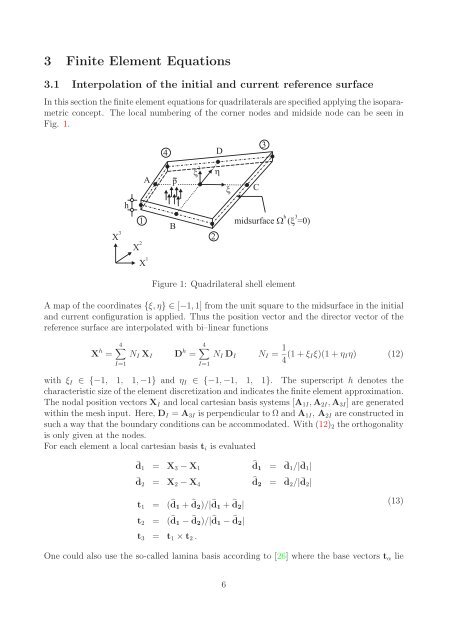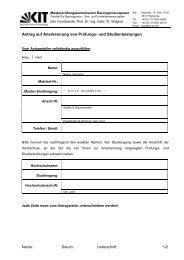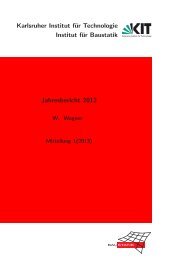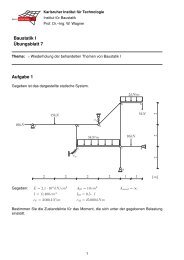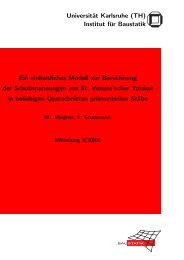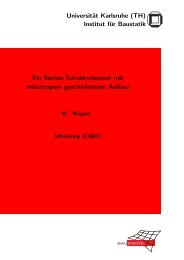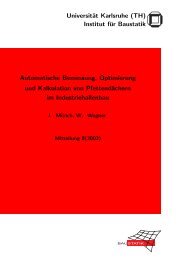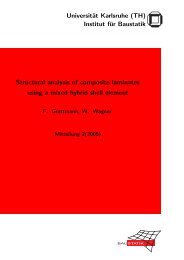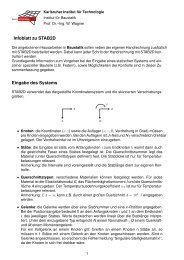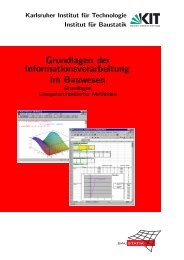Universität Karlsruhe (TH) - am Institut für Baustatik
Universität Karlsruhe (TH) - am Institut für Baustatik
Universität Karlsruhe (TH) - am Institut für Baustatik
You also want an ePaper? Increase the reach of your titles
YUMPU automatically turns print PDFs into web optimized ePapers that Google loves.
3 Finite Element Equations<br />
3.1 Interpolation of the initial and current reference surface<br />
In this section the finite element equations for quadrilaterals are specified applying the isopar<strong>am</strong>etric<br />
concept. The local numbering of the corner nodes and midside node can be seen in<br />
Fig. 1.<br />
4<br />
D<br />
3<br />
X 3<br />
h<br />
A p<br />
3<br />
<br />
C<br />
h<br />
1 midsurface ( =0)<br />
B<br />
2<br />
<br />
X 2 X 1 Figure 1: Quadrilateral shell element<br />
A map of the coordinates {ξ,η} ∈[−1, 1] from the unit square to the midsurface in the initial<br />
and current configuration is applied. Thus the position vector and the director vector of the<br />
reference surface are interpolated with bi–linear functions<br />
4∑<br />
4∑<br />
X h = N I X I D h = N I D I N I = 1<br />
I=1<br />
I=1<br />
4 (1 + ξ Iξ)(1 + η I η) (12)<br />
with ξ I ∈ {−1, 1, 1, −1} and η I ∈ {−1, −1, 1, 1}. The superscript h denotes the<br />
characteristic size of the element discretization and indicates the finite element approximation.<br />
The nodal position vectors X I and local cartesian basis systems [A 1I , A 2I , A 3I ] are generated<br />
within the mesh input. Here, D I = A 3I is perpendicular to Ω and A 1I , A 2I are constructed in<br />
such a way that the boundary conditions can be accommodated. With (12) 2 the orthogonality<br />
is only given at the nodes.<br />
For each element a local cartesian basis t i is evaluated<br />
¯d 1 = X 3 − X 1 ̂d 1 = ¯d 1 /|¯d 1 |<br />
¯d 2 = X 2 − X 4 ̂d 2 = ¯d 2 /|¯d 2 |<br />
t 1 = (̂d 1 + ̂d 2 )/|̂d 1 + ̂d 2 |<br />
t 2 = (̂d 1 − ̂d 2 )/|̂d 1 − ̂d 2 |<br />
t 3 = t 1 × t 2 .<br />
(13)<br />
One could also use the so-called l<strong>am</strong>ina basis according to [26] where the base vectors t α lie<br />
6


